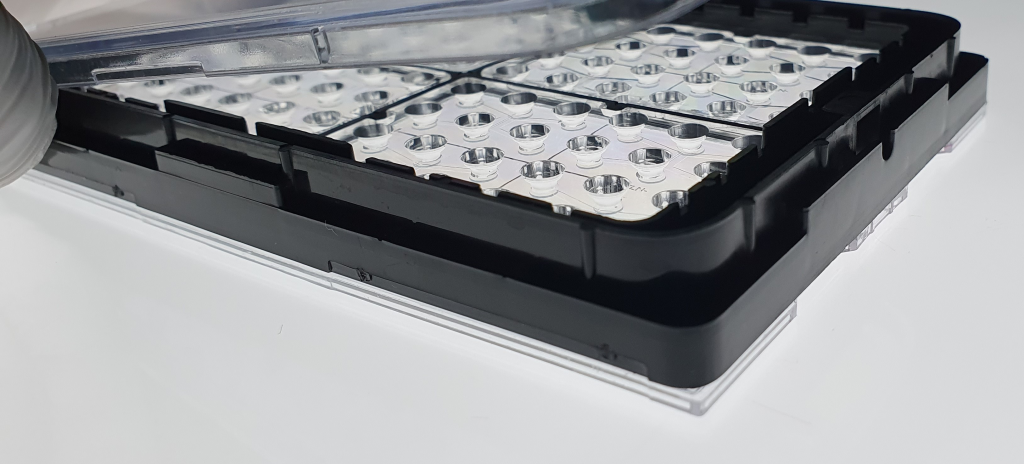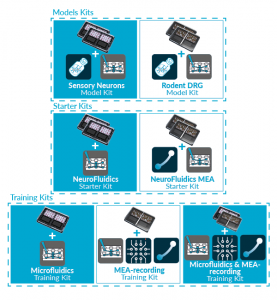MICROFLUIDICS IS NOW JUST
1-CLICK AWAY WITH NETRI SHOP
Discover our new exclusive package
organs-on-chip kits and all our
neuro-organs-on-chip devices.

Pain has various causes, nociceptive or neuropathic, with chemotherapy-induced peripheral neuropathic pain affecting 60-80% of patients and becoming chronic in 20-40%, significantly impacting their quality of life. Chemotherapy agents, classified into six categories, lead to different levels of neuropathies. The limited effectiveness of pain management is partly due to a lack of relevant research models, as current animal-based in vivo models lack translationability and in vitro assays lack anatomical complexity to understand pain mechanisms and toxicity.

Organs-on-chips enable the reproduction of highly segregated neural circuits, isolating neuron somas from their axons to mimic human neuroanatomical architecture for more relevant injury or treatment paradigms.
To bridge the gap between in vivo models & current in vitro assays and human studies, we developed pain models using human induced pluripotent stem cell (hiPSC)-derived sensory neurons and adapted the culture onto relevant compartmentalized microfluidic devices.
• DuaLink NeuroFluidics Devices & PNS NeuroFluidics Cultures
• hiPSC-derived sensory neurons somas in channel 1 & projections in channel 3
• Chemotherapy agents added in channel 1 (somas only) on channel (projections only)
• Compartmentalization to explore distinct modes of action and selectively adding them to either the cell body or distal axonal compartment
Paclitaxel stabilizes microtubules and thus interferes with axonal transport. The major hallmark of CIPN neuropathology is a “dying back” axon degeneration that proceeds in a distal-to-proximal fashion.
• Dose-dependent axons degeneration: no effect of paclitaxel at 10 nM on axon surface coverage, but marked decrease at 50 nM
• Isolation of distal axons from soma and proximal axons
• Segregation of the mode of action of Paclitaxel agent onto each cell comportment
Test your compound on our ready-to-use NeuroFluidics Cultures with reference compound already on the market or having failed in the clinical phase.

Oxaliplatin, a platinum agent, disrupts DNA through crosslinking, inhibiting replication. The major hallmark of CIPN neuropathology is a “dying back” axon degeneration that proceeds in a distal-to-proximal fashion.
• Decrease in surface area covered by distal axons in channel 3 (100 µM) and drastic increase in axonal debris.
• Isolation of distal axons from soma and proximal axons
• Segregation of the mode of action of Oxaliplatin agent onto each cell comportment
Test your compound on our ready-to-use NeuroFluidics Cultures with reference compound already on the market or having failed in the clinical phase.

Humanized in vitro CIPN models for a wide variety of applications.
• Human sensory neurons-on-chip model
• Screening of potential drugs or therapeutic interventions for their effectiveness in preventing or treating CIPN
NeoBento™, the standard format for NeuroFluidics Devices chips, available up to 4 QuarterBentos™ (up to 16 chips).
• Standard ANSI format (96-well plate)
• Pump-free & expensive equipment-free
• Standard equipment (liquid handling & imaging) compatibility
Compartmentalized microfluidics devices to recreate two modalities of chemotherapy-induced neuropathic pain.
• Discrimination of mode of action and mechanism of neurotoxicity
• Segregation of therapeutic modality: topical versus systemic
In-depth reading of the data to better understand the study results and potential implications.
• Electrophysiological recording (MEA)
• Imaging (Immunofluorescence, Calcium Imaging…)
.
• Biochimic analysis (ELISA, Lysis cells analysis, Liquid Chromatography…)
• Technological Transfert
• FTE & Screening Services
• Co-development
• Analytical Services
• NeuroFluidics Devices
• NeuroFluidics Cultures
• NeuroFluidics Digital
• Training & Organs-on-chip Kits
Discover our new exclusive package
organs-on-chip kits and all our
neuro-organs-on-chip devices.

ORGANS-ON-CHIP KITS
Quickly and easily adopt organs-on-chip
into users’ research

